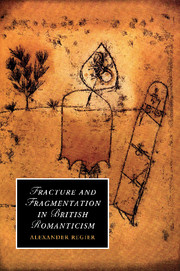Book contents
- Frontmatter
- Contents
- Acknowledgements
- List of abbreviations
- Broken origins: an introduction
- 1 A brotherhood is broken: Babel and the fragmentation of language
- 2 Figuring it out: the origin of language and anthropomorphism
- 3 Forces trembling underneath: the Lisbon earthquake and the sublime
- 4 A blue chasm: Wordsworth's The Prelude and the figure of parenthesis
- 5 Letters from the grave: John Keats's fragmented corpus
- 6 The doubling force of citation: De Quincey's Wordsworthian archive
- 7 Philological fractures: Paul de Man's Romantic rhetoric
- Notes
- Bibliography
- Index
- CAMBRIDGE STUDIES IN ROMANTICISM
2 - Figuring it out: the origin of language and anthropomorphism
Published online by Cambridge University Press: 06 July 2010
- Frontmatter
- Contents
- Acknowledgements
- List of abbreviations
- Broken origins: an introduction
- 1 A brotherhood is broken: Babel and the fragmentation of language
- 2 Figuring it out: the origin of language and anthropomorphism
- 3 Forces trembling underneath: the Lisbon earthquake and the sublime
- 4 A blue chasm: Wordsworth's The Prelude and the figure of parenthesis
- 5 Letters from the grave: John Keats's fragmented corpus
- 6 The doubling force of citation: De Quincey's Wordsworthian archive
- 7 Philological fractures: Paul de Man's Romantic rhetoric
- Notes
- Bibliography
- Index
- CAMBRIDGE STUDIES IN ROMANTICISM
Summary
FIGURATIVE LANGUAGE AND ANTHROPOMORPHISM
Jean-Jacques Rousseau begins the second chapter of his Essai sur l'origine des langues (1753) with a meditation on the invention of speech. He maintains that we often misconstrue the fundamental character of the origin of language by mistaking the primacy of passionate poetry for a more rational geometry: ‘The language of the first men is put before us as though it were the languages of Geometers, while we see that they were the languages of Poets. This must have been so. We did not begin by reasoning but by feeling.’ This assertion about the pre-eminence of the poetic is part of a longer story about the broken origins of language and Romanticism. This chapter is, in part, about that story. It shifts our attention from linguistic-architectonic fragmentation (the Babelian tower) to a tropological linguistic fracture, namely anthropomorphism. This provides us with a different case study of how fracture is a particularly powerful notion through which to grasp Romanticism. Within the context of this larger framework, the chapter begins by asking how and why the origin of language and poetry are so often identified with one another. The figural and conceptual strategies employed by Romantic poets, rhetoricians, and philosophers who advocate this conjunction reveal that the fracturing trope of anthropomorphism occupies a special place in the field of linguistic theory and historiography. Anthropomorphism emerges not ‘just’ as a rhetorical figure, but as a linguistic move with deep philosophical implications.
- Type
- Chapter
- Information
- Fracture and Fragmentation in British Romanticism , pp. 52 - 74Publisher: Cambridge University PressPrint publication year: 2010

